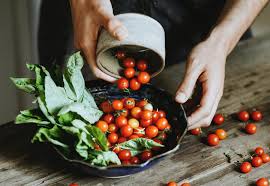With the rains lashing out Tamil Nadu over the last so many days- the vegetable prices have spiralled up and even some of the essential ones have become dearer. One such costly pick now is the ripe, red tomatoes. A berry fruit of the Solanum Genus- the scientific name is Solanum lycopersicum and is known as Thakaali in Tami and Tamatar in Hindi.
History of tomatoes:
Tomato is known to have originated first in Central America, in Mexico during the Aztecan civilization. IT is believed that the name tomato originated from the Nahautl language- where this new fruit was called as “tomatl” meaning ” The swelling fruit”. Soon- the name originated to French, Portugese and French languages and is refined to tomato as we know today.
Around 1500 AD the Spanish explorers and colonizers brought tomato seeds from Mexico back to Spain and soon introduced it to the European world. Throughout Southern Europe, the tomato was quickly accepted into the kitchen, yet as it moved north, more resistance was apparent.
The British, for example, admired the tomato for its beauty, but believe that it was poisonous, as its appearance was similar to that of the wolf peach. China, Indian and the United States lead the world today in the production of tomato. There are many known varieties of tomatoes that are grown worldwide. Some of the popular names are Cherry tomatoes, Plum tomatoes, Grape tomatoes, Beefsteak tomatoes, Roma tomatoes (known as Bangalore tomatoes in India), Alicante tomatoes, Brandywine tomatoes and Garden Peach.
Click here to read about the health benefits of Indian foods
Benefits:
Tomato is known to be a rich source of Vitamin C- constituting for about 22% followed by Vitamin A (16%). It also has traces of Potassium, Iron, Magnesium, Vitamin B6 and Calcium in addition to dietary fibres. Tomato is also known to contain a good amount of flavonones, flavonols, carotenoids, glycosides among others. Tomatoes are known for maintaining cardiovascular support- hence they are a regular presence in our daily recipes.

The factors that aid in this are due to the presence of antioxidants and regulation of fats in the bloodstream. Tomato’s premier antioxidant is the carotenoid lycopene. Lycopene (and a related group of nutrients) has the ability to help lower the risk of lipid peroxidation in the bloodstream. Researches published also indicate that tomatoes help lower the risk of prostate cancer in man.
Alpha-tomatine is a saponin phytonutrient which has the ability to alter the metabolic activity in developing prostate cancer cells. Among younger men, diets rich in beta-carotene may play a protective role against prostate cancer, according to a study conducted by the Harvard School of Public Health’s Department of Nutrition. Collagen, the skins support system, is reliant on vitamin C as an essential nutrient that works in our bodies as an antioxidant to help prevent damage caused by the sun, pollution and smoke, smooth wrinkles and improve overall skin texture. Tomatoes also contain coumaric acid and chlorogenic acid that work to protect the body from carcinogens that are produced from cigarette smoke.
Cooking uses:

With regard to Indian cooking0- Tomato has always been a premier ingredient. The staple diet of South Indians- Rasam- has tomato as a mainstay. Tomato and tamarind are used to give the sour taste to the dishes prepared. In some recipes- tomato is also used in Sambhar recipes- which make them find an essential place in your regular South Indian kitchen.
In North Indian recipes- starting from simple Dal Tadka recipes- to thick gravies like Rajma/Channa Masala- tomatoes are added. They are usually pureed and added to form the gravy part for most of the North Indian dishes along with onion, ginger and garlic. Tomato soup is another very popular dish that is famous pan India. Tomatoes are also washed well and consumed raw as a part of a salad or chopped into very fine pieces and strewn upon Papad (a recipe known as Kachumber). Add some tomatoes to your menu today and indulge in some tasty eating!
